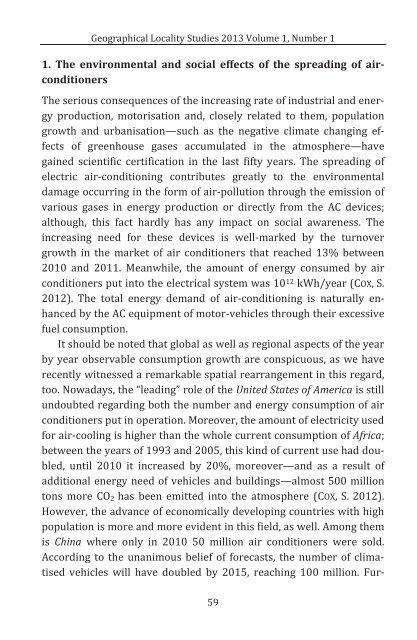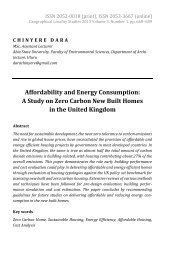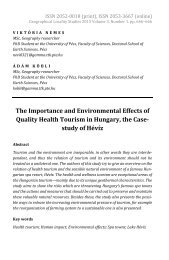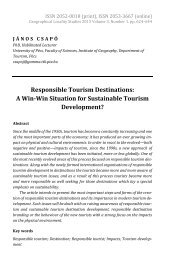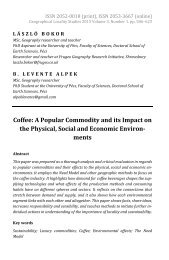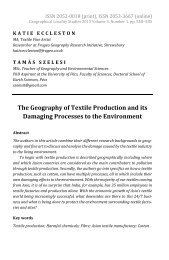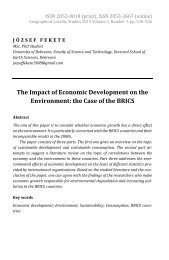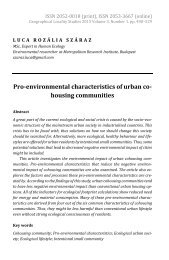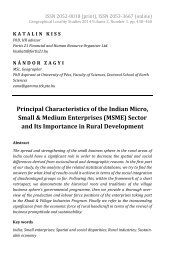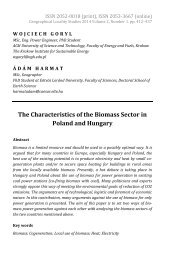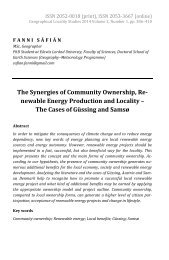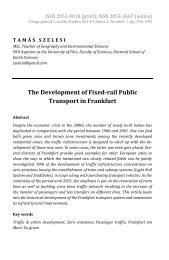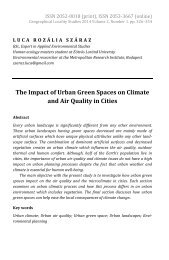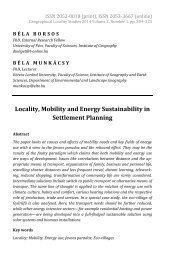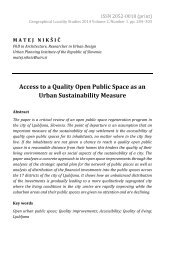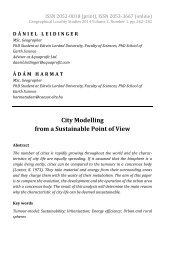Nándor Zagyi: Traditional Energy – Free Solutions for Ventilation and Air-Cooling in Arid Tropical Areas of Asia
Nowadays, more and more air-conditioning devices are installed to cool the inner spaces of dwelling and public buildings in the populous developing countries. Therefore, it is worth drawing attention to those traditional methods and architectural forms by which comfortable air conditions could be generated in the hot arid and semi-arid areas of the Planet.
Nowadays, more and more air-conditioning devices are installed to cool the inner spaces of dwelling and public buildings in the populous developing countries. Therefore, it is worth drawing attention to those traditional methods and architectural forms by which comfortable air conditions could be generated in the hot arid and semi-arid areas of the Planet.
You also want an ePaper? Increase the reach of your titles
YUMPU automatically turns print PDFs into web optimized ePapers that Google loves.
Geographical Locality Studies 2013 Volume 1, Number 1<br />
1. The environmental <strong>and</strong> social effects <strong>of</strong> the spread<strong>in</strong>g <strong>of</strong> airconditioners<br />
The serious consequences <strong>of</strong> the <strong>in</strong>creas<strong>in</strong>g rate <strong>of</strong> <strong>in</strong>dustrial <strong>and</strong> energy<br />
production, motorisation <strong>and</strong>, closely related to them, population<br />
growth <strong>and</strong> urbanisation—such as the negative climate chang<strong>in</strong>g effects<br />
<strong>of</strong> greenhouse gases accumulated <strong>in</strong> the atmosphere—have<br />
ga<strong>in</strong>ed scientific certification <strong>in</strong> the last fifty years. The spread<strong>in</strong>g <strong>of</strong><br />
electric air-condition<strong>in</strong>g contributes greatly to the environmental<br />
damage occurr<strong>in</strong>g <strong>in</strong> the <strong>for</strong>m <strong>of</strong> air-pollution through the emission <strong>of</strong><br />
various gases <strong>in</strong> energy production or directly from the AC devices;<br />
although, this fact hardly has any impact on social awareness. The<br />
<strong>in</strong>creas<strong>in</strong>g need <strong>for</strong> these devices is well-marked by the turnover<br />
growth <strong>in</strong> the market <strong>of</strong> air conditioners that reached 13% between<br />
2010 <strong>and</strong> 2011. Meanwhile, the amount <strong>of</strong> energy consumed by air<br />
conditioners put <strong>in</strong>to the electrical system was 10 12 kWh/year (COX, S.<br />
2012). The total energy dem<strong>and</strong> <strong>of</strong> air-condition<strong>in</strong>g is naturally enhanced<br />
by the AC equipment <strong>of</strong> motor-vehicles through their excessive<br />
fuel consumption.<br />
It should be noted that global as well as regional aspects <strong>of</strong> the year<br />
by year observable consumption growth are conspicuous, as we have<br />
recently witnessed a remarkable spatial rearrangement <strong>in</strong> this regard,<br />
too. Nowadays, the “lead<strong>in</strong>g” role <strong>of</strong> the United States <strong>of</strong> America is still<br />
undoubted regard<strong>in</strong>g both the number <strong>and</strong> energy consumption <strong>of</strong> air<br />
conditioners put <strong>in</strong> operation. Moreover, the amount <strong>of</strong> electricity used<br />
<strong>for</strong> air-cool<strong>in</strong>g is higher than the whole current consumption <strong>of</strong> Africa;<br />
between the years <strong>of</strong> 1993 <strong>and</strong> 2005, this k<strong>in</strong>d <strong>of</strong> current use had doubled,<br />
until 2010 it <strong>in</strong>creased by 20%, moreover—<strong>and</strong> as a result <strong>of</strong><br />
additional energy need <strong>of</strong> vehicles <strong>and</strong> build<strong>in</strong>gs—almost 500 million<br />
tons more CO 2 has been emitted <strong>in</strong>to the atmosphere (COX, S. 2012).<br />
However, the advance <strong>of</strong> economically develop<strong>in</strong>g countries with high<br />
population is more <strong>and</strong> more evident <strong>in</strong> this field, as well. Among them<br />
is Ch<strong>in</strong>a where only <strong>in</strong> 2010 50 million air conditioners were sold.<br />
Accord<strong>in</strong>g to the unanimous belief <strong>of</strong> <strong>for</strong>ecasts, the number <strong>of</strong> climatised<br />
vehicles will have doubled by 2015, reach<strong>in</strong>g 100 million. Fur-<br />
59


